Amazon land speculators poised to gain control of vast public lands
Land thieves have fought for years to wreck Brazil’s large system of conserved lands, which protect rainforest. Now the agribusiness lobby is helping them achieve their goal.
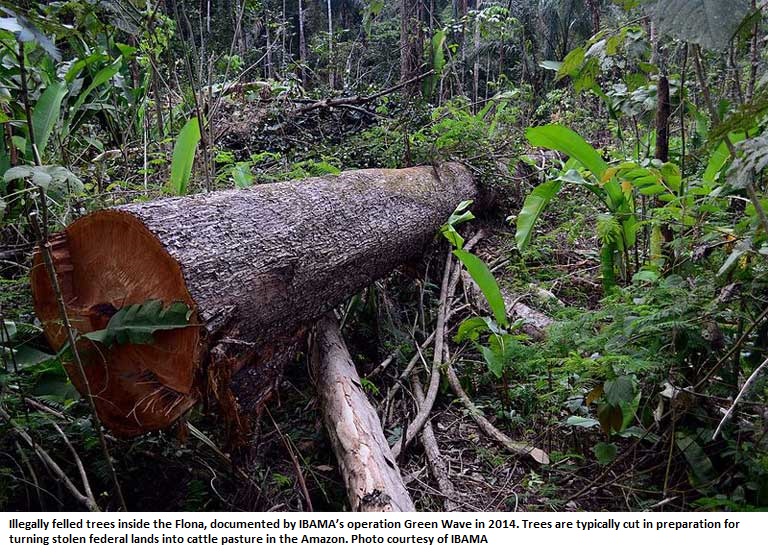
- In the Brazilian Amazon, the paving of highways makes adjacent forests far more attractive to land thieves, resulting in major deforestation. The Sustainable BR-163 Plan of 2006 created vast swathes of protected land — eight new conservation units — to prevent land theft and deforestation from happening near the vulnerable BR-163 highway in Pará state.
- From the start, land speculators wanted to get their hands on one of those units, the National Forest of Jamanxim, known as “Flona Jamaxim.” They’ve occupied large areas of the Flona, making it one of Brazil’s conservation units with the most serious illegal forest clearing. Illicit activities there helped turn the region into a very violent place.
- The rise of the agribusiness-friendly Temer administration in August 2016 emboldened the land speculators. Working with the bancada ruralista, the agribusiness lobby, they got Temer to pass interim measures in December 2016, dismembering Flona Jamanxim, reclassifying 305,000 hectares, and allowing land thieves to keep the land they had seized.
- Other conservation units are being targeted: in January 2017, the government announced plans to slash conservation units in Amazonas state — dismembering the Biological Reserve of Manicoré, National Park of Acari, and National Forests of Aripuanã and Urupadi, and more. If approved, one million hectares will lose environmental protection.
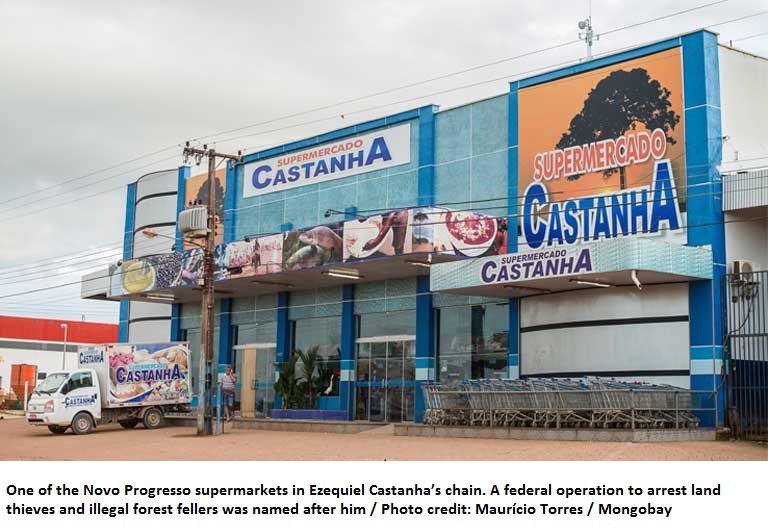
The Tapajós River Basin lies at the heart of the Amazon, and at the heart of an exploding controversy: whether to build 40+ large dams, a railway, and highways, turning the Basin into a vast industrialized commodities export corridor; or to curb this development impulse and conserve one of the most biologically and culturally rich regions on the planet.
Those struggling to shape the Basin’s fate hold conflicting opinions, but because the Tapajós is an isolated region, few of these views get aired in the media. Journalist Sue Branford and social scientist Mauricio Torres travelled there recently for Mongabay, and over coming weeks hope to shed some light on the heated debate that will shape the future of the Amazon. This is the eleventh of their reports.
Novo Progresso is a frontier town in northwest Pará state. “Here we don’t have robberies,” a cabby told us proudly on arrival. “Here everyone is armed.” The weapons are often concealed but, indeed, most locals are packing guns, a reality representative of the region’s long history of violence and lawlessness.
Founded in 1991, Novo Progresso sprang up around a clandestine landing strip built to provide a rapid way in and out of this remote, inaccessible region by those earning money – and often a lot of it — through illegal gold mining and logging. Peasant families were arriving too, though traveling more slowly along the unpaved BR-163 highway.
Today commerce is bustling here, though some hotel and supermarket owners are out on bail, awaiting trial for illegal logging, land theft and conspiracy to commit crimes — all swept up in 2014’s Castanheira Operation, a federal bust named after Ezequiel Castanha, owner of the Castanha supermarket chain, who, it was discovered, had earned more money from his illegal activities than his licit ones.
Now pressure by Novo Progresso land speculators — working with Brazil’s agribusiness lobby in the Temer administration and the National Congress — has begun dismantling Brazil’s vast network of conservation units, exposing millions of hectares of currently protected Amazon rainforest to an onslaught of deforestation and development.
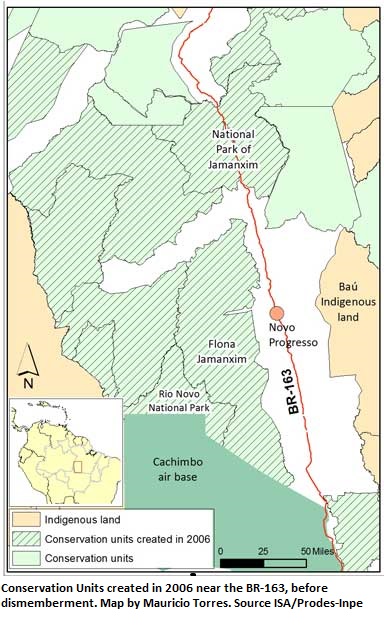 A highway pierces the Amazon
A highway pierces the Amazon
The BR-163 highway is also Novo Progresso’s main street, and at the peak of the soy harvest, hundreds of huge trucks rumble through town, stirring up choking clouds of dust. But some residents are happy at the noise and pollution, saying it signals progress for the once isolated region.
After an almost 45 year wait, the road’s paving is nearly done and much of Mato Grosso’s bumper soy crop is now flowing along the new northern truck and water route to the Atlantic coast, instead of being driven thousands of miles south to the ports of Santos and Paranaguá.
When we visited last November, the hot topic under discussion was whether or not the National Forest of Jamanxim, known as Flona Jamanxin, was going to be dismembered.
This conservation unit, covering 1.3 million hectares (3.2 million acres), an area the size of Puerto Rico, extends alongside the BR-163 to the west of Novo Progresso. It was created, along with seven other conservation units in 2006, as part of an innovative set of environmental protection measures called the Sustainable BR-163 Plan drawn up in 2003 when the paving of the highway was announced.
National Forests, once established, don’t allow lands within them to be registered in the name of a private individual. As a result, an Amazon land thief can’t occupy a plot, clear it, ranch on it, and then sell it at a great profit. So “speculative deforestation” — which occurs whenever a new road penetrates Brazilian forest — drops drastically when this kind of conservation unit is established on either side of it, even though the units often exist more on paper than in reality.
However, when Flona Jamanxim was created, there were already a few peasant families living inside the unit, and they were understandably reluctant to leave. That fact gave wealthy Novo Progresso land speculators a pretext for rejecting the Flona, and they whipped up wide-scale support for their position. The speculators, already active in the region, had expected the usual land boom that had accompanied other new roads, and didn’t accept that the government was excluding them from making a fortune by invading, clearing, and selling off land that was rapidly rising in value due to the paving of the BR-163.
They organized protests, blockaded the highway and published blogs in which they claimed that the Flona had “frozen the region and stopped farmers producing.” They demanded the the conservation unit be abolished or reduced in size.
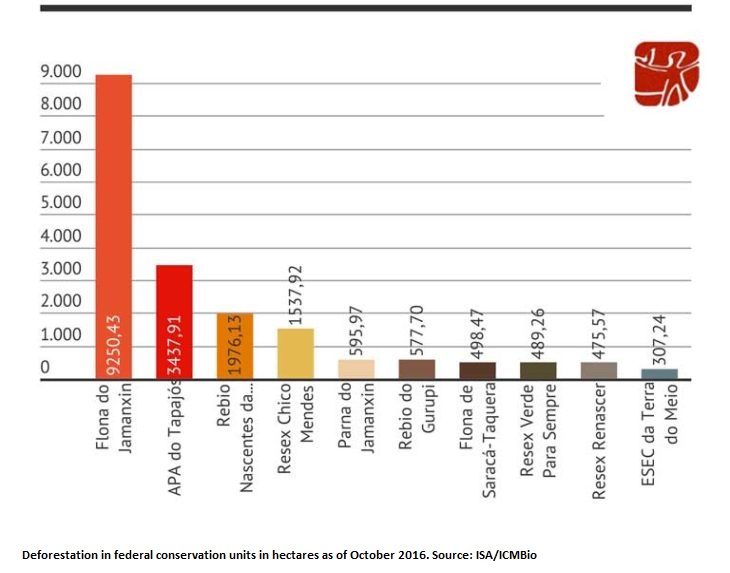
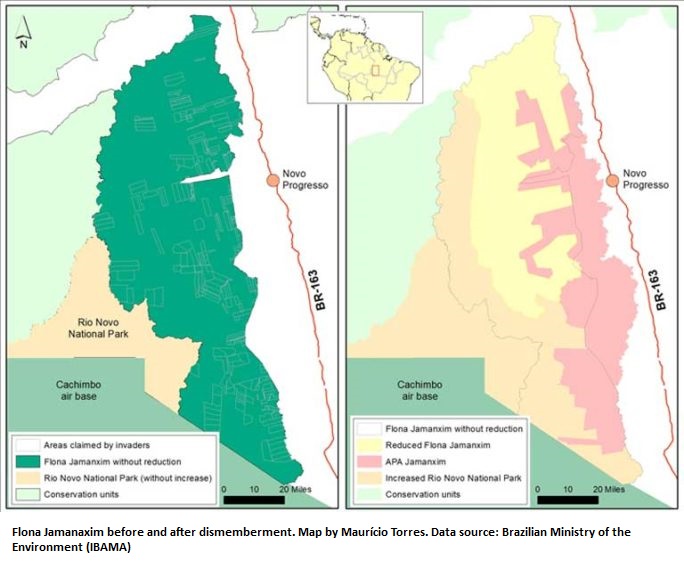
Land grabbers pounce
This political pressure led to an evaluation by the federal Chico Mendes Institute for the Conservation of Biodiversity (ICMBio), the body that administers federal conservation units.
The agency’s 2009 study assessed the speculators’ demand to shrink Flona, and found, contrary to what they alleged, that 67 percent of the land holdings within the unit had been created after the creation of the Flona in 2006, and that 60 percent of the new “residents” didn’t live on their plots. In other words, wealthy land grabbers had been hard at work to seize, deforest and develop public land.
ICMBio’s conclusion: a Flona reduction “would lead to a serious setback in the government’s conservation strategy that would have unpredictable consequences, not just for the area of the Flona itself, but also for various other conservation units in Amazonia, which would inevitably suffer from pressure from landowners, invasions and political interests.”
The report did, however, recommend that small adjustments be made to satisfy the land claims of peasant families living there before 2006. It recommended that an area of 35,000 hectares (86,500 acres) — 3.7 percent of the total — be removed from the Flona for them.
This wasn’t what the speculators wanted and they went on pressuring the government, while continuing to illegally occupy large areas of the Flona.
IBAMA and ICMBio pushed back and tried to regain control of the unit. In 2008 and 2009 they undertook large scale enforcement operations, even confiscating cattle reared within the Flona. As a result, forest cutting within the unit declined markedly in 2010, 2011 and 2012.
But in 2013 ICMBio suffered huge budget cuts, with newspapers describing the Institute’s situation as “penury.” It was forced to give up much of its fieldwork, and land thieves and loggers returned to business as usual. Flona Jamanxim figured near the top of the list of the country’s conservation units with the most serious illegal forest clearing.
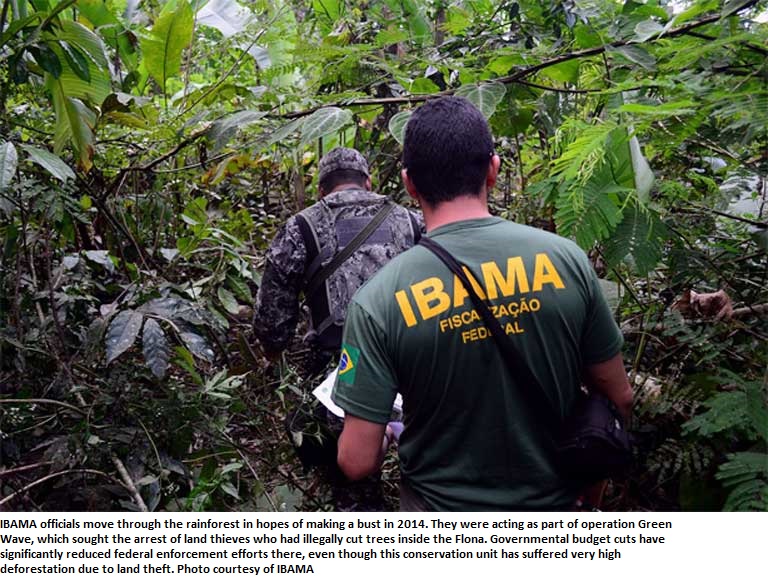
IBAMA and ICMBio continued running one-off operations, but couldn’t stop the rising tide of land crime. Imazon, a research institute, showed that by 2016 that the average size of a private holding in the Flona had jumped to 1,843 hectares (4,554 acres), a far bigger holding than any peasant family would occupy.
There were many violent conflicts. For instance, in June 2016, when an IBAMA team went to the Flona to battle illegal logging, a military policeman was assassinated. Jair Shmitt, the general coordinator of environmental monitoring at IBAMA, described Flona Jamanxim as “one of the most violent conservation units in Amazonia,” located in a region which had “professional assassins involved in illegal felling and in the theft of public land.”
IBAMA (the ministry of the environment) and ICMBio (the Chico Mendes Institute of Biodiversity Conservation) did not provide responses to questions submitted for this article.
The dismembering of Flona Jamanxim
The impeachment of President Dilma Rousseff in August 2016 and government takeover by the agribusiness friendly Temer administration emboldened the Novo Progresso speculators. They met regularly in Novo Progresso and organized trips to Brasilia to talk with the bancada ruralista, the agribusiness lobby.
We met Agamenom da Silva Menezes, the President of the Rural Trade Union of Novo Progresso and the spokesman for the landowners, in his office in the center of town, just after he returned from one of those Brasilia trips.
In good spirits, despite a long, tiring bus journey, he told us that the problem with Flona Jamanxim was its original set up: “This Flona was created at full speed; they ordered it to be signed, without following the proper norms.” Smiling, he assured us everything was going to be sorted out soon, now that there was “a more positive atmosphere” in Brasilia.
He was also keen to tell us his views about the environment: “Brazil is poor because it doesn’t deforest. The word, deforest, is a provocation. In fact, what is happening is an alteration in the forest. The [deforested] area isn’t left bare. It’s used for crops, for pasture, for something. A planted forest replaces a planted forest.”
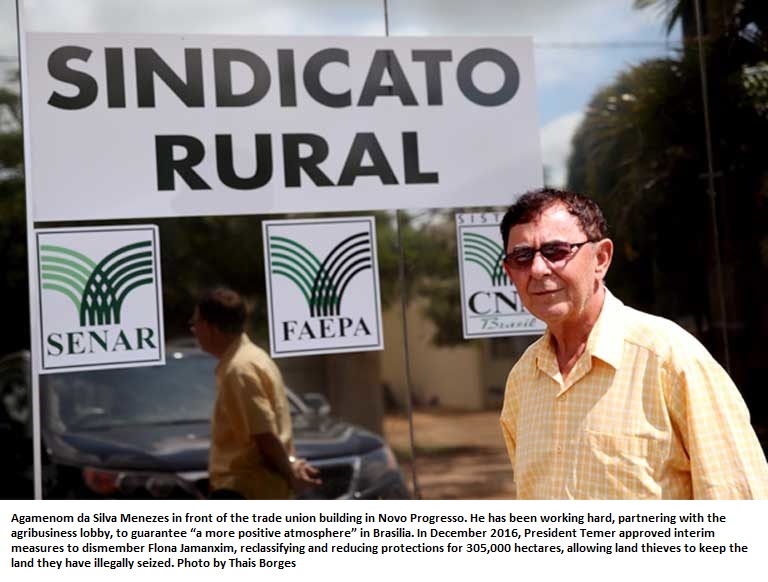
Not everyone in Novo Progresso agrees with Agemenom: we met Lincoln Brasil Queiroz in his small garden with lovely tropical flowers — a shady oasis in the hot, grey town. He’s one of the few farmers in the region to have legitimate land titles because his father purchased property from the federal government’s land reform institute, INCRA, in the 1970s.
He was worried about the political consequences of the possible dismembering of the Flona: “If the land thieves win, those who have organized the campaign will be strengthened,” he said. It will send out a harmful message: “Those who have carried on felling forest, illegally occupying the land, will be rewarded. For the local society, it will seem that crime pays.”
The Federal Public Ministry (MPF), Brazil’s independent prosecutors, shares his concerns. With rumors flying about the Flona’s imminent size reduction, the MPF filed a suit calling for the dismemberment process to be halted and for “an intensification in the monitoring” of the Flona. It also demanded that the region’s slaughterhouses be held to account for processing cattle reared on illegally cleared public land.
Agemenom was unruffled by the MPF’s actions, possibly because he knew what was coming. In December, President Temer, with the support of the minister of the environment, José Sarney Filho, signed interim measures MP 756 and MP 758. The actions eliminated part of Flona Jamanxim, reclassifying the area demanded by the landowners as an Area of Environmental Protection (APA), a much less restrictive form of conservation unit, and one that would allow those who had stolen federal land already to stay on it.
Agemenom’s group, which dictates the editorial line of Novo Progresso’s newspaper, O Progresso, was exultant at the “good news”: “With this, we expect that the west region of the state to have greater economic development with the arrival of heavy investment, both from the private and public sectors.”
The two interim measures already have the force of law but they could be overturned by Congress. This is, however, very unlikely to happen. Indeed, the cuts in the Flona could become more severe: 15 amendments have been submitted, of which ten propose further reductions in the Flona. Two deputies — Zé Geraldo and Francisco Chapadinha, both from Pará — are calling for the extinction of the Flona Jamanxim, essentially opening the entire forest to speculators. Congress is expected to vote at the end of March.
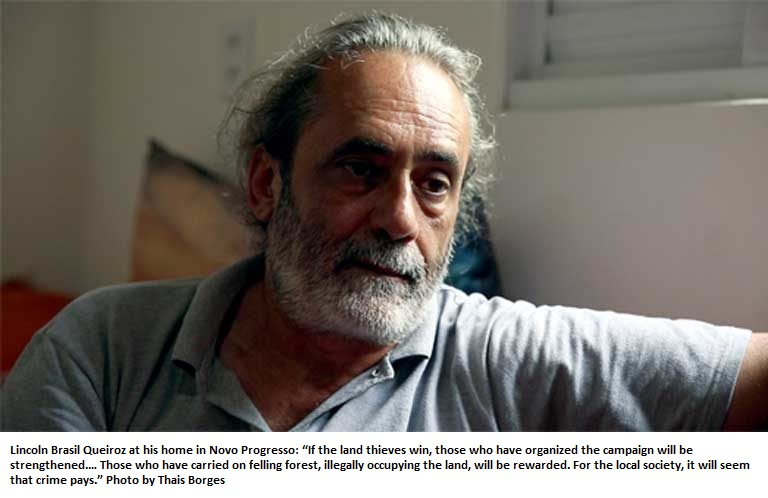
The Sustainable BR-163 Plan: death by federal cuts
The dismembering of the Flona Jamanxim has sounded the death knell for the Sustainable BR-163 Plan designed 15 years ago to demonstrate that the paving of roads and forest protection can be compatible in the Amazon.
But in truth, the whittling away began much earlier. According to Brent Millikan, Amazon Program Director at the NGO International Rivers, the Sustainable BR-163 Plan of 2006 was soon superseded by the Program for the Acceleration of Growth (PAC) of 2007, a high-profile government program for heavy investment in infrastructure.
At that time, the overriding priority of the Workers Party (PT) was to stay in power, he said, and to achieve this they “formed alliances with traditional political and economic groups who were interested above all in getting their hands on public assets — public money, natural resources and so on — and this was absolutely incompatible with the objectives of the Sustainable BR-163 Plan.”
Even before the dismemberment of the Flona, the Plan had clearly failed. According to Juan Doblas, who monitors the region’s deforestation for the Geoprocessing Laboratory at the NGO, Socioenvironmental Institute (ISA), “ten years after the licensing of the work, accumulated deforestation had reached the worst projections” made about the impact of the paving of the road on the forest.
According to Doblas, “the situation would have been much worse, had it not been for the creation of the conservation units,” but now even this gain is being reversed.
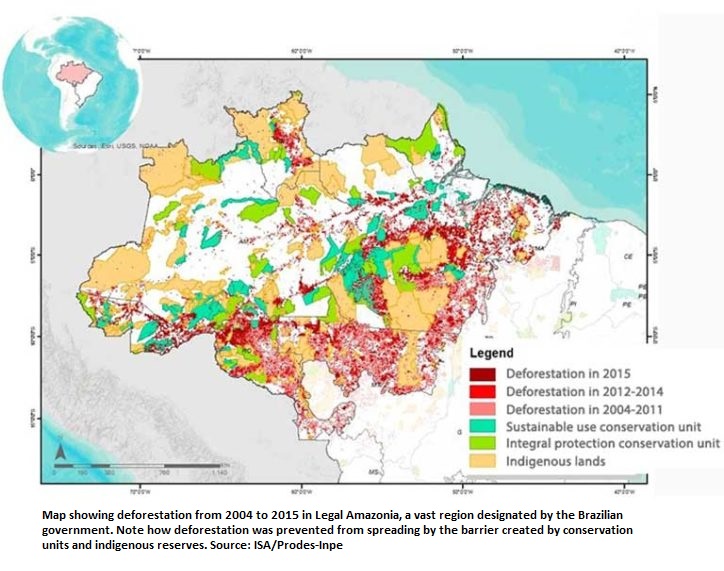
Setting a precedent for environmental disaster
It was President Dilma Rousseff who created the precedent of reducing the size of protected areas through interim measures (MPs); previously it took a long and complex procedure in Congress to reduce the size of conservation units. She did so out of her desire to build the large São Luiz do Tapajós hydroelectric project, and in 2012 exercised her executive power to redraw the borders of conservation units that stood in the way of this mega-dam.
Even though the construction of the São Luiz do Tapajós dam has been halted for now, the precedent of altering the limits of protected areas using MPs was established, giving Temer cover for his recent Flona decision.
In the technical note that the Ministry of the Environment published announcing the dismemberment of Flona Jamanxim, it referred to: “the great disparity between the proposals presented by the ICMBio and the Association of Producers.” The conflict between the two groups, it said, had made it impossible to manage the Flona effectively.
The “way out” found by the ministry is to rearrange the conservation units. In its new measures, it takes away just over half, 743,000 hectares (1.8 million acres), from the Flona Jamanxim. It then gives just over half of this land, 438,000 hectares (1.1 million acres), to the neighboring National Park of Rio Novo, a category with tougher environmental protection. However, the remaining 305,000 hectares (754,000 acres) are reclassified as an Area of Environmental Protection, the APA Jamanxim — a much freer conservation classification, which allow land speculators easy access.
At the same time, the ministry took away part of the National Park of Jamanxim “to permit the passage of Ferrogrão,” the new commodities railroad fast-tracked for construction in 2016 by President Temer to transport soy and other crops to the north for export.
All of these boundary shifts provide clear examples of the subordination of conservation to the government’s current infrastructure and agribusiness expansion plans.
Paulo Carneiro, ICMBio’s Director for the Creation and Management of Conservation Units, admitted that the dismembering will harm Flona Jamanxim, but said that “we were witnessing such an escalation in the conflict [between the ICMBio and the landowners] that all possibility of dialogue was being destroyed.”
But another ICMBio employee, speaking off the record, is horrified at the precedent now established. “The reduction in the size of Flona Jamanxim shows criminals that, if they invade and clear a conservation unit, they can get it reclassified and keep the land,” he told Mongabay. “I want to know if Brasilia will come in the future and help us contain the invasion of more conservations units, as this is sure to happen.”
Doblas agrees. He said that ICMBio has given in to the bullying tactics of the land thieves: “When the government declares an APA on the frontier of the expansion of agribusiness, it is effectively reinforcing a speculative race in which various agents are going to fight over the land, which is now seen as ‘thievable,’ and then clear it and occupy it.”
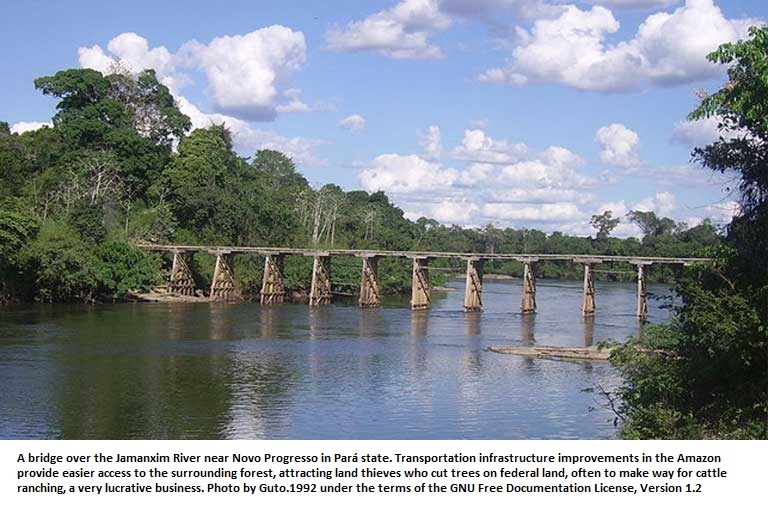
More conservation losses ahead
Now that they have tasted victory, the land speculators seem hungry for more.
Other conservation units are being targeted: in January 2017, the government announced a plan to radically reduce the size of conservation units in the state of Amazonas — dismembering the Biological Reserve of Manicoré, National Park of Acari, and National Forests of Aripuanã and Urupadi, and extinguishing the APA of the Campos de Manicoré.
If that policy goes ahead, about one million hectares (2.5 million acres) will lose the environmental protection they currently enjoy. In February an open letter from 21 conservation NGOs called on the Brazilian government to rethink the proposal.
But, based on the political strength, influence and reach of the agribusiness lobby, a change in policy seems unlikely. In fact, Eliseu Padilha, who heads the General Staff of the Presidency of the Republic, has himself been accused of land theft within another conservation unit — the Serra Ricardo Franco Park — in Mato Grosso.
Adriana Ramos, coordinator of Policy and Law at the NGO Socioenvironmental Institute (ISA), told Mongabay that “agribusiness’s strategy, as expressed by the Parliamentary Front for Agriculture and Livestock, is to weaken and neutralize the scope of environmental legislation and the territorial rights of traditional people and communities.” What we are witnessing, she says, in “an attack on social and environmental rights by agribusiness”.
Not surprisingly, the landowners see it differently. In his interview with Mongabay, Agamenom da Silva Menezes, the President of the Rural Trade Union of Novo Progresso, said that society has always progressed and that change is inevitable. Leaning towards us, he asked: “Do you miss dinosaurs?”
By: Sue Bradford and Maurício Torres / Source: Mongabay / The Dawn News / March 27, 2017
